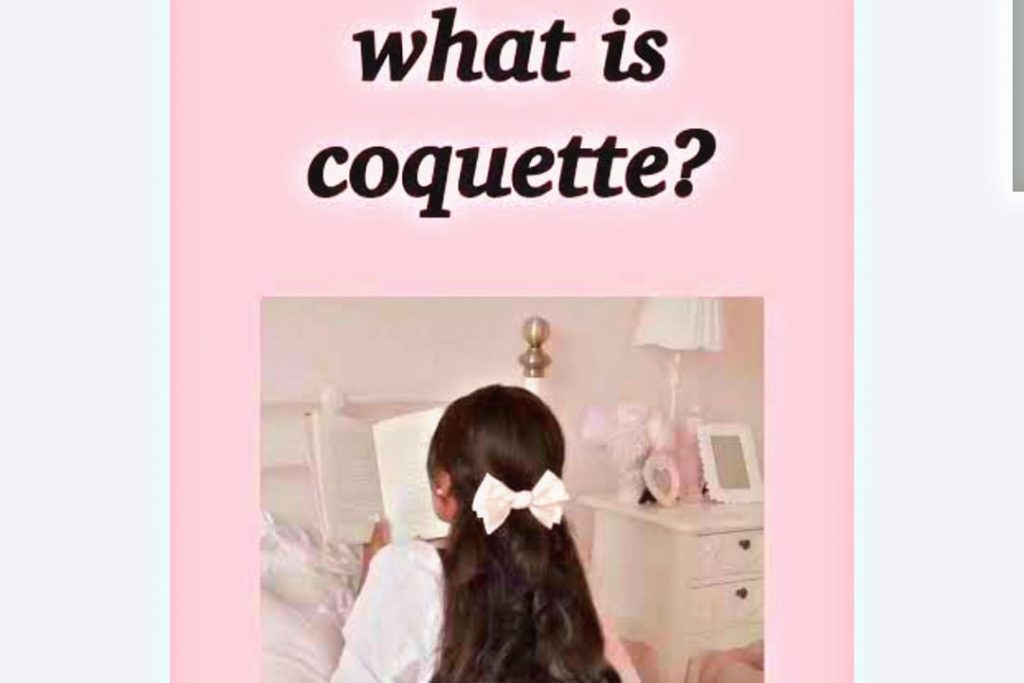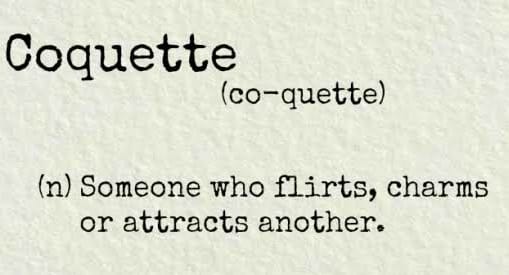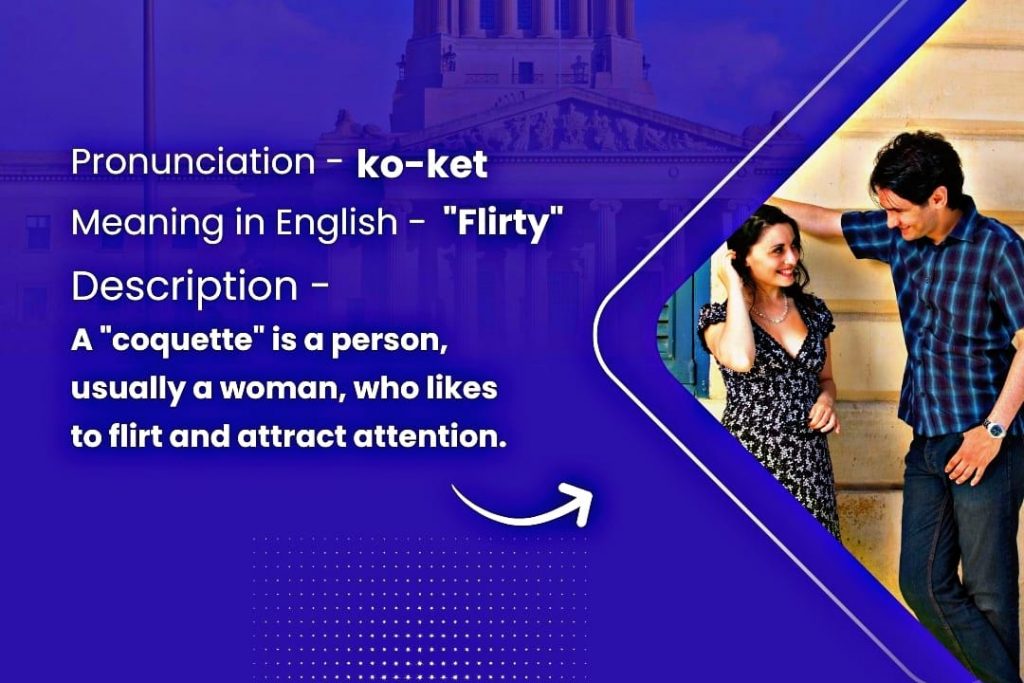The term “coquette” has been used for centuries to describe a particular type of person—someone who is playful, flirtatious, and, at times, enigmatic in their interactions with others. Whether in literature, art, or modern-day relationships, the coquette archetype continues to captivate people’s imaginations. But what exactly does coquette mean, and where does this intriguing concept come from? In this article, we will explore the Coquette Definition, its historical context, its evolution in society, and how it is perceived today.
What is a Coquette?

The word coquette is derived from the French word “coquet,” meaning “flirtatious” or “dandy.” Originally, “coquet” referred to a man who was excessively concerned with his appearance and charm, but over time, it became more closely associated with women. Today, the term is generally used to describe a woman who is deliberately flirtatious, often without serious intentions of pursuing a romantic relationship.
Coquette Definition in Detail
A coquette is someone who engages in flirtation with the intention of gaining attention, admiration, or affection without necessarily wanting to commit to a serious romantic relationship. Coquettes typically enjoy the act of captivating others with their charm, wit, and beauty. They may tease, compliment, and create an aura of mystery, leaving others intrigued and eager to win their affections. The key characteristic of a coquette is that her flirting is playful and often superficial, rather than sincere or deeply emotional.
In modern parlance, a coquette can be thought of as someone who enjoys the game of attraction but is not necessarily interested in the deeper emotional investment that comes with a serious relationship. The behavior may involve coyness, attention-seeking, and a certain level of emotional distance, which often leaves the person being flirted with in a state of longing or curiosity.
Gendered Nature of the Term
Historically, the term coquette has often been gendered, with its use primarily referring to women. While it has occasionally been used to describe men—especially those who display similar traits of charm and playfulness—it has more commonly been applied to women throughout literature and cultural discussions. The coquette persona has, at times, been seen as a symbol of feminine power, particularly in societies where women had limited agency in direct romantic pursuits.
However, in contemporary discussions, the concept of the coquette is evolving. While it still retains its association with flirtation and allure, people of all genders can exhibit coquette-like behavior. In modern dating culture, men and women alike may embrace flirtation as a tool of attraction, using it to test boundaries, entertain, or even gain validation.
The Historical Context of the Coquette

The notion of the coquette has roots in European literature, particularly in France, where the term gained prominence in the 17th and 18th centuries. One of the earliest and most famous representations of the coquette was in the French comedy of manners. In these plays and literary works, coquettes were often depicted as clever, charming, and slightly manipulative women who used their beauty and flirtation as a means of gaining power or attention.
Coquette in French Literature
The coquette archetype became widely known in France with the publication of Pierre de Marivaux’s plays in the early 18th century. Marivaux’s characters were often drawn from the bourgeoisie, and they played with the boundaries of social norms, using seduction and flirtation to manipulate the behavior of those around them. Marivaux’s play Le Jeu de l’Amour et du Hasard (The Game of Love and Chance) is one example where flirtation and coquetry take center stage, with the characters engaging in a dance of attraction, misdirection, and emotional tension.
Perhaps the most well-known representation of the coquette is Madame de Merteuil in Pierre Choderlos de Laclos’s novel Les Liaisons Dangereuses (Dangerous Liaisons). In this classic 18th-century French novel, Madame de Merteuil is a master of manipulation, using her beauty and intelligence to control the men around her. She is an archetypal coquette, using flirtation and sexual allure as tools for gaining power and influence.
The Coquette as a Feminine Ideal
In the 18th and 19th centuries, the coquette was often seen as a figure of feminine allure and subtlety. Her flirtations were not necessarily about pursuing relationships but rather about maintaining control over the attention of men. In a time when women had limited autonomy in romantic relationships and marriages were often arranged, the coquette could wield her charm to assert a form of power.
While some viewed the coquette as a problematic figure—associated with deceit and emotional manipulation—others saw her as a symbol of female empowerment. She was a woman who could navigate the rigid social expectations of her time by using her charms to get what she wanted, all while remaining enigmatic and distant.
The Decline of the Coquette Ideal
As societal attitudes toward gender roles evolved in the 19th and 20th centuries, the coquette persona began to lose its appeal. The rise of the feminist movement and changes in relationship dynamics led to a reevaluation of how women were expected to behave in romantic settings. The idea of a woman using flirtation as a manipulative tool began to be viewed more negatively in certain social circles.
However, the concept of the coquette did not entirely disappear. Instead, it began to take on new meanings. While the coquette may no longer be the dominant ideal of feminine charm, she continues to exist as a symbol of playful seduction, subtle power, and emotional complexity in literature, art, and popular culture.
Coquette Behavior in Modern Contexts

In the 21st century, the concept of the coquette is far from obsolete. In fact, the rise of social media, online dating apps, and a culture of instant gratification has reinvigorated interest in the art of flirtation and the coquette persona. While the meaning of a coquette has shifted somewhat, the essence of her behavior—teasing, playful flirtation, and emotional ambiguity—remains the same.
The Coquette in Modern Dating
In modern dating culture, the coquette may use flirtation to establish a connection with someone but may not show full emotional investment. This behavior is often evident in the early stages of dating, where individuals play a kind of “cat-and-mouse” game, testing each other’s attraction and interest.
Online dating apps like Tinder, Bumble, and Hinge have created platforms for flirtation to thrive, where coquette-like behavior can be observed in profiles, messages, and interactions. Users often rely on witty one-liners, teasing exchanges, and playful banter to establish a sense of connection before deciding whether to pursue something deeper. The game of flirtation—so central to the coquette persona—remains a powerful tool in modern dating.
The Coquette and Social Media
Social media platforms, particularly Instagram, TikTok, and Twitter, have given people new avenues for expressing the coquette persona. Many individuals, particularly influencers and public figures, cultivate an air of mystery by sharing curated content that shows off their best features without revealing too much. This creates a sense of allure and intrigue, similar to the behaviors of a classic coquette.
Additionally, the language of flirtation has evolved with the digital age. Emojis, memes, and GIFs are used as playful tools to express interest or tease others, much in the same way that traditional flirting would have been done in person. As a result, the coquette has adapted to the fast-paced nature of modern communication, continuing to hold a place in contemporary society.
The Coquette and Gender
While the term coquette has traditionally been used to describe women, it is important to note that flirtation is not gender-specific. Both men and women can engage in coquette-like behavior, playing games of attraction and flirtation. In today’s dating culture, men are just as likely to use flirtation as a form of self-expression, and they may employ coquette-like tactics in their interactions as well.
The shift in gender roles and expectations in relationships has allowed for a more fluid interpretation of the coquette archetype, one that can be embraced by anyone who wishes to flirt, tease, and allure, regardless of gender.
The Psychology Behind Coquette Behavior
Flirting and coquetry are often rooted in a complex web of psychological motivations. For many, flirtation is not just about seeking romantic or sexual attention—it is also about self-validation, emotional control, and social power. The coquette often enjoys the sense of control she gains by manipulating the emotions of others and holding them at arm’s length, all while maintaining a sense of intrigue.
The Coquette and Emotional Distance
One of the most defining features of the coquette is emotional distance. She may enjoy attention, but she typically avoids forming a deep emotional connection with the person who is vying for her affection. This emotional distance creates a sense of longing and intrigue, keeping others interested and eager to win her affections.
Psychologically, the coquette may enjoy the chase rather than the actual relationship. This can be linked to a fear of commitment or vulnerability, as maintaining a sense of independence allows the coquette to avoid emotional entanglements that could lead to disappointment or heartbreak.
Conclusion: The Enduring Allure of the Coquette
The coquette—with her flirtatious charm, playful teasing, and emotional distance—continues to captivate people’s imaginations. From her origins in French literature to her modern incarnation in digital spaces, the coquette has evolved but never lost her seductive appeal. Whether in a novel, a film, or a dating app, the coquette remains a symbol of power, allure, and mystery, reminding us of the delicate dance of attraction that continues to shape human relationships.

